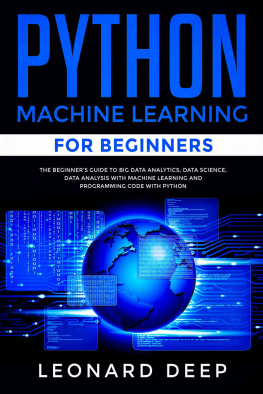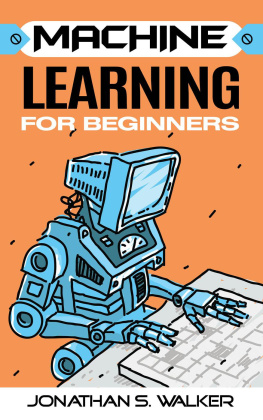Deep - Python Machine Learning for Beginners
Here you can read online Deep - Python Machine Learning for Beginners full text of the book (entire story) in english for free. Download pdf and epub, get meaning, cover and reviews about this ebook. year: 2019, genre: Computer. Description of the work, (preface) as well as reviews are available. Best literature library LitArk.com created for fans of good reading and offers a wide selection of genres:
Romance novel
Science fiction
Adventure
Detective
Science
History
Home and family
Prose
Art
Politics
Computer
Non-fiction
Religion
Business
Children
Humor
Choose a favorite category and find really read worthwhile books. Enjoy immersion in the world of imagination, feel the emotions of the characters or learn something new for yourself, make an fascinating discovery.
Python Machine Learning for Beginners: summary, description and annotation
We offer to read an annotation, description, summary or preface (depends on what the author of the book "Python Machine Learning for Beginners" wrote himself). If you haven't found the necessary information about the book — write in the comments, we will try to find it.
Deep: author's other books
Who wrote Python Machine Learning for Beginners? Find out the surname, the name of the author of the book and a list of all author's works by series.
Python Machine Learning for Beginners — read online for free the complete book (whole text) full work
Below is the text of the book, divided by pages. System saving the place of the last page read, allows you to conveniently read the book "Python Machine Learning for Beginners" online for free, without having to search again every time where you left off. Put a bookmark, and you can go to the page where you finished reading at any time.
Font size:
Interval:
Bookmark:
Python Machine Learning for Beginners
The Beginners Guide to Big Data Analytics, Data Science, Data Analysis with Machine Learning and Programming Code with Python
LEONARD DEEP
Download the Audio Book Version of This Book for FREE
If you love listening to audio books on-the-go, I have great news for you. You can download the audio book version of this book for FREE just by signing up for a FREE 30-day audible trial! See below for more details!

Audible Trial Benefits
As an audible customer, you will receive the below benefits with your 30-day free trial:
- FREE audible book copy of this book
- After the trial, you will get 1 credit each month to use on any audiobook
- Your credits automatically roll over to the next month if you dont use them
- Choose from Audibles 200,000 + titles
- Listen anywhere with the Audible app across multiple devices
- Make easy, no-hassle exchanges of any audiobook you dont love
- Keep your audiobooks forever, even if you cancel your membership
- And much more
Click the links below to get started!
For Audible US
For Audible UK
For Audible FR
For Audible DE
Copyright 2019 Publishing. All Rights Rrvd.
No rt f thi publication m be rrdud, ditributd, r transmitted in n frm or b n means, inluding hting, rrding, r thr electronic or mechanical mthd, r b any infrmtin trg nd retrieval tm withut th rir written rmiin of th ublihr, except in th f vr brief quotations mbdid in critical rviw nd certain thr nnmmril u rmittd b right law.
Introduction
Welcome and much appreciation for downloading this book. The book will cover the entire Python programming from an absolute beginner perspective and place more emphasis on the first three chapters to enable the reader to get furnished. Chapter 3 of the book covers how to install and run Python IDE and including your first Hello World Program.
This book is written with the understanding that the student is completely new to Python programming. For this reason, the author takes measures not to assume or leave out any part. Unlike other books, the author decided to split content meant for the first chapter into three chapters to gradually introduce the learner into Python programming. The author explains systematically how to get started, keywords, statements, variables, data types and type conversion among other basic areas of Python programming. After providing examples, the author also provides exercises. The exercises are carefully selected and will not overwhelm an absolute beginner. They are meant to help the learner systematically build skills and confidence in Python programming. Once through with the book, the learner will be more than ready to handle any Python programming challenge. Let us begin.
Chapter 1: Introduction to Machine Learning
The topics discussed in this chapter come from an analysis of the main requirements in data scientist jobs from popular technology companies. The topics are as listed below:
- Linear Regression(Simple)
- Linear Regression(Multiple)
- Evaluating Performance of Models
- Hierarchical Clustering
- KNN
- Kernel SVM
- Clustering K-Means
- Principle Component Analysis-PCA
- Pandas (Python Library for Handling Information or Data)
Artificial intelligence, ML, and data science are some of the trending subjects in the technology field today. Bayesian analysis and data mining are the ones currently trending and this has contributed to the increasing demand for ML (ML).
ML is a field that focuses on the programming of computer systems hence causing them to learn and improve with expertise automatically.
ML Algorithms Applications
- Data mining
- Games
- Robotics
- Expert computer systems
- Recognition of patterns
- Vision processing
- Language processing
- Stock market trend and weather forecast
Procedures involved in ML
An efficient ML project entails the following steps:
- Definition of the problem
- Preparation of data
- Evaluation of algorithms
- Improving the results
- Presentation of the results
The perfect way of starting on ML using Python is working through a project from the beginning to the end and cover the major steps such as summarizing data, evaluating algorithms, loading information, and predicting. This will provide you with a replicable technique that can be used for each dataset. Adding further data to improve the results is also an available option.
To understand machine learning you are required to understand how files work in Python. The following section discusses Python files.
Files are used for future storage. To read from a file we need to open it and once through with it, we have to close it to free the resources.
The inbuilt function open() in Python is used to launch a file.
Example
Start IDLE.
Navigate to the File menu and click New Window.
Type the following:
file_name=open(lesson.txt)
file_name=open(D:/Tutorials/lesson.txt)
Exercise
a. Locate a text file on your computer and open using the Python open()
b. Locate a doc/docx file on your computer and open using Python open()
c. Locate an excel file on your computer and open using Python open()
Additionally, Appending a, write w, or read r the file helps indicate the mode when launching the file. The modes are determined by the context and can be changed as the need arises. Python also allows us to indicate binary or text mode depending on our programming needs. By default, the file is opened in text read mode. Images and non-text files are handled in the binary mode.
The r is used to launch the file for reading and is the default. The w is preferred when launching writing permissions. For exclusive file creation, we use the x mode. The operation will be unsuccessful if the file already we want already exists. The other mode, a is used to launch a file for adding data at the file end while retaining earlier content. For the t mode, it will launch the file in default text mode. The b mode is used to launch the file in binary mode. Lastly, the + mode is used for launching the file to allow reading and writing.
Exercise
a. Open an existing .txt file on your computer in Pythons read mode.
b. Open the same text file in a. in Pythons write mode.
c. Open an existing image on your computer in binary mode.
It is encouraged to specify the file encoding type as it varies from operating system platform to another and may produce different results if not specified.
Example
Start IDLE.
Navigate to the File menu and click New Window.
Type the following:

The method close() is used.
Example
Start IDLE.
Navigate to the File menu and click New Window.
Type the following:
file_name=open(my text.text, encoding=utf-8)
file_name.close()
Exercise
a. Locate a .txt file on your computer, open it using open() and close it using close()
b. Locate a .doc file on your computer, open it using open() and close it using close().
Next pageFont size:
Interval:
Bookmark:
Similar books «Python Machine Learning for Beginners»
Look at similar books to Python Machine Learning for Beginners. We have selected literature similar in name and meaning in the hope of providing readers with more options to find new, interesting, not yet read works.
Discussion, reviews of the book Python Machine Learning for Beginners and just readers' own opinions. Leave your comments, write what you think about the work, its meaning or the main characters. Specify what exactly you liked and what you didn't like, and why you think so.




